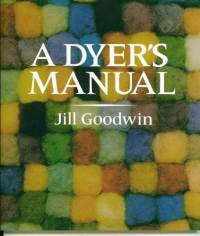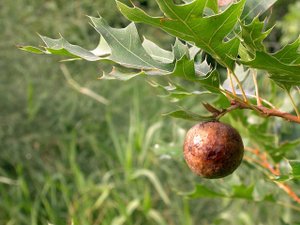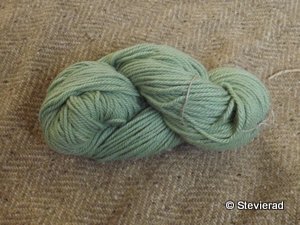Have you ever tried dyeing wool with something that had thought would give a brilliant colour?
You’ve looked at the way it looks or stains and thought to yourself ‘Ohhh that’s a good one – I’ll try that out’ only to dye with it, and get a colour nothing close to what you had expected. Or worse still no colour at all!
I have!
I use wool for nalbinding for viking re-enactment, and thought it would be a good idea to use natural dyed wools to make my socks, hats, mittens and cowls. So I went looking for information about wool and natural dyes. An early find, and a great book for any natural dyer is Jill Goodwins book ‘A Dyer’s Manual’. It’s an older book, first published in 1982, but the information is still relevant. She also includes a list of dye materials and the mordants that they need. I have found other books, but this is the one I keep returning too!
There’s also a wealth of information on the internet. The Woolery is an online site that has information on natural dyes and mordants
http://www.woolery.com/store/pc/Information-on-Natural-Dyes-c567.htm
I found that all natural dyes are either substantive (which need no mordant) or non-substantive (where a mordant is needed).
Substantive dyes include onion skins, acorns and walnut shells. Non-substantive dyes include elderberries, ivy, ragwort and ivy.
So what’s a mordant? Well, a mordant makes the dye ‘stick’ to the wool. It comes from the Latin verb ‘mordre’ which literally means ‘to bite’; the mordant helps the dye ‘bite’ into the wool.
You can use the mordant in several ways;
1) On the washed damp yarn before dyeing,
2) In the dyebath itself when you are dyeing the wool,
3) After dyeing in the dyebath,
4) Or for real colour fastness before and after dyeing.
So the next question I had was ‘what do I use as a mordant?’
Historically there are quite a few that our ancestors could have used, and you can still use them today. These included;
stale urine
salt
vinegar
wood ash in solution
oak galls
raw alum
water in which rusty iron has been soaked
willow or oak bark
copper pieces that have been soaked in ammonia for about 2 weeks.
I’ve tried some of these, but they can be time consuming to source. Oak galls are hard to find… and if you’re curious about what they look like…
And as for the stale urine; I can assure it smells as bad as it sounds! And you have to collect it……….
So being a modern minded Viking I found some modern versions. These are mainly metal salts, which are thought to make the wool more porous. This makes the wool more able to absorb the dye and improve the fastness of the colour, even with the substantive dyes. There are several but I’ve only mentioned the ones that I use.
I mostly use Alum (aluminium sulphate). You can get it from most chemists. It’s used in combination with Cream of Tartar (3-4oz alum to 1oz cream of tartar) which brightens the colour and keeps the wool soft.
I use Jill Goodwins recipe from ‘A Dyer’s Manual’ pages 32-36.
‘Allow 3-4oz alum to 1lb of wool (so you’d need about 1oz of cream of tartar). Dissolve the alum and cream of tartar in a little boiling water and add to the pot. Add the damp wool and bring to a simmer point over about 1 hour. Simmer for a further 1 hour, stirring gently from time to time. Use immediately, or rinse, dry and store for further use’.
One thing to note; don’t stir the wool continuously as your wool may felt (i.e stick together).
I also use Copper Sulphate. Be careful when handling this one as it’s poisonous. It’s also an unpredictable mordant, and tends to ‘sadden’ or darken the colours. Used on its own it gives the wool a greenish blue colour.
Again from ‘A Dyers Manual ‘the recipe I use is
‘8oz wool,
2gals soft water,
2 teaspoons cream of tartar and
4 teaspoons copper sulphate.’
I’ve made some mordant from rusty iron – and had the same effect from dying in an iron pot. This one also saddens the colour. I found this recipe to make an iron mordant on the internet;
‘boil 5 litres of water with 2 cups of vinegar and 1 cup of rusty nails for one hour. Leave it to stand for 24 hours and then pour off the water. This water is the mordant.’
Don’t use a pot or any utensil that you use for cooking for mordanting wool in as the mordants can be toxic !! And rubber gloves are a good idea too.
When I mordant wool I use a steel pot and utensils that I store separately fro my cooking utensils.
Also using an iron or copper pot can affect the colour (almost as if a mordant had been used!). I also use rain water we collect in a water butt.
Finally, because many of the mordants are toxic, be careful when disposing of them. I tend to store them for future use.
One further word of warning – dyeing can become addictive! Once you’ve tried it and enjoyed it, plants around you take on a whole new appearance!!




mordant […] comes from the Latin verb ‘mordre’ which literally means ‘to bite.
Yes, but as an impossible french, i have to point out that it’s indeed from french present participle of “mordre” (to bite), itself from latin mordere.
Thanks for your info. I have made my son a handspun and woven viking tunic for his SCA events. I am very interested in the viking dyes used.